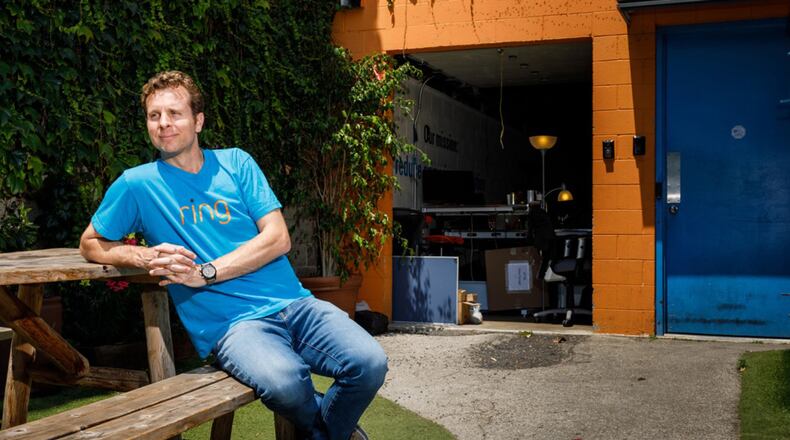That arm’s length relationship works both ways. Since Amazon bought Ring — the home-security startup Siminoff founded that builds smart doorbells, security cameras and related gadgets — Siminoff said he’s made connections at the new parent company, but Seattle isn’t micromanaging the startup’s work.
Amazon, Siminoff said, is “kind of leaving us alone,” an approach that reflects the online retail and technology giant’s preference for decentralized teams, and its habit of giving relatively free rein to companies it’s acquired.
Ring hasn’t been left entirely alone, of course.
The company, which Amazon bought in April for $853 million in cash, had its debut in September as a star in Amazon’s constellation. At an event at Seattle headquarters, Amazon devices chief Dave Limp introduced dozens of products and services — from updates to the Alexa voice software, to new Echo speakers and a new version of the Stick Up Cam, a Ring-built outdoor-security camera.
“It’s surreal,” Siminoff said afterward, standing in a mock living room on the 30th floor of Amazon’s Day 1 tower designed as a demonstration ground for new gadgets. “The decentralized nature of this company allows for a lot of entrepreneurial groups to exist and move fast.”
The Ring deal represented an expansion of Amazon’s bet on smart-home technology, the proliferation of internet-enabled devices from microwaves to door locks and light bulbs. Amazon has tried to position Alexa, its voice software that inhabits its Echo devices and gadgets built by other companies, at the center of that universe.
For Amazon, Ring adds home security to the retailer’s growing array of focus areas. The company has embraced the mission statement Ring impresses upon its 2,000 or so employees, and even paints it on walls at its Santa Monica, Calif., headquarters: Reduce crime in neighborhoods.
“I can think of no nobler mission,” Amazon’s Limp said on stage recently.
Although it has vaulted into Amazon’s sphere, Ring has unpretentious roots.
Technology startups aren’t shy about turning their humble beginnings into corporate mythology. Facebook was launched in a Harvard dorm. Hewlett-Packard and Google began in garages.
A garage in Los Angeles also features in Ring’s creation story, but so did an unsuccessful appearance on reality television.
Siminoff’s startup was running out of time and money in the fall of 2013 when he won a spot on “Shark Tank” to show off his battery-powered, Wi-Fi enabled doorbell camera. From a $10,000 set built to look like the front of a home, Siminoff pitched the ABC reality show’s investors on what was then called “DoorBot.”
None of the sharks bit. Siminoff went back to the garage empty-handed, “broke and broken,” he said.
But the appearance — a few minutes of free advertising on national television — proved to be a lifeline, jump-starting sales and giving the company some breathing room.
Ring would raise $1 million from investors later that year and nearly $300 million over the next four years to fund sleeker and more effective versions of his doorbell camera. The fundraising haul included a contribution from the Alexa Fund, Amazon’s program to back startups that might bolster the voice software’s reach.
Siminoff was also aware of the potential that Amazon could turn into a powerful competitor, a worry shared by a wide range of manufacturers and sellers on Amazon’s own platform.
“On the one side, while we wanted to work with them, we always sort of looked at it knowing that, if Jeff (Bezos) and Co. decided that this was something (good) for their customers, they’d do it,” he said.
Eventually, they did, launching Amazon Key, a delivery program that paired control of a smart lock with an Amazon-built home-security camera.
Amazon at the time said it saw value in building its own technology for home security, but shortly after that it started shopping, acquiring home-security-camera maker Blink in December. Two months later, word leaked that Amazon would scoop up Ring, too.
The deal has given Ring more resources to put into product development, Siminoff said, including a neighborhood watch-like crowdsourcing app called Neighbors, which launched shortly after the Amazon deal. Siminoff said the software, which cost more to develop than most of Ring’s lineup of hardware, is an indication that the company’s focus on neighborhood safety goes beyond doorbells and cameras.
“I can ask for things internally,” Siminoff said of Ring’s relationship with Amazon. “But I’m not being pulled apart by things asked of us.”
Ring is in the process of moving its headquarters from Santa Monica, near the home base of Amazon’s Studios unit, to a larger space in Hawthorne, Calif., south of the Los Angeles airport.
Siminoff says he has no plans to leave.
There’s plenty of precedent for Amazon acquirees sticking around. Tony Hseih, chief executive of Zappos.com at the time Amazon bought the online-footwear retailer, is still with the company nine years later. So are the founders of audiobook maker Audible, movie and television database IMDB and Twitch.
John Mackey, founder of Whole Foods, has stayed on to help manage the integration of the organic grocer into the broader company.
“That is a testament to the environment that they build,” Siminoff said. Plus, “I don’t really like to play golf, I don’t know what else I’d do during the day. I intend to stay.”
About the Author
